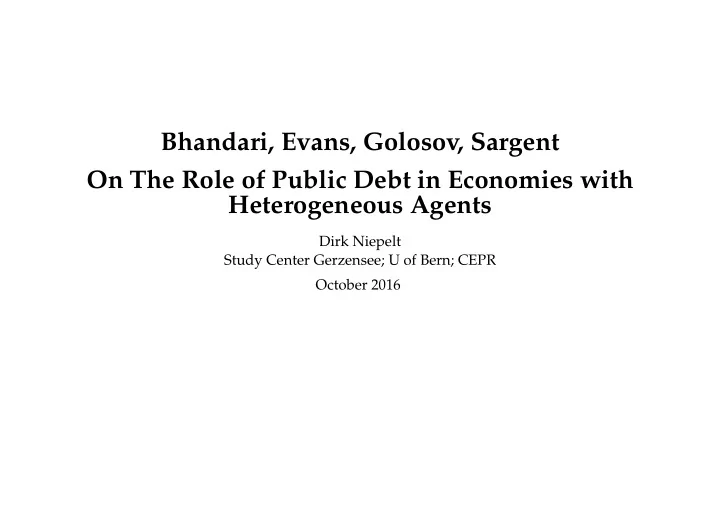

Bhandari, Evans, Golosov, Sargent On The Role of Public Debt in Economies with Heterogeneous Agents Dirk Niepelt Study Center Gerzensee; U of Bern; CEPR October 2016
A Nice Paper Two themes • Ricardian equivalence • Ramsey policy (using debt limits) • connected by “debt” ...but two papers? Parallels to Werning (2007) who • Allows for capital, but assumes complete markets • Discusses Ricardian equivalence • “Speculates” about implications of imperfect participation Comments on “On The Role of Public Debt in Economies with Heterogeneous Agents” A Nice Paper
Ricardian Equivalence General formulation • State µ , policy sequence p , support CE • New ( µ ′ , p ′ ) such that – household choice sets unchanged – at CE allocation/prices, government bc satisfied (production possibilities unchanged, firm input/output restrictions unchanged) • Then, ( µ ′ , p ′ ) support same CE, bar asset positions (Gonzalez-Eiras and Niepelt, 2015) Comments on “On The Role of Public Debt in Economies with Heterogeneous Agents” Ricardian Equivalence
Examples i. Single household, timing of lump sum taxes ii. Single household subject to distorting taxes, timing of lump sum tax component iii. Multiple households, keeping individual choice sets unchanged iv. Only distorting taxes (Bassetto and Kocherlakota, 2004) Ricardian equivalence results in paper build on example ii. • Multiple households • Distorting taxes with lump sum component Comments on “On The Role of Public Debt in Economies with Heterogeneous Agents” Ricardian Equivalence
Findings (propositions 1 (=4), 2) • No legacy cost of public debt (more basic than RE) Because lump sum tax can undo Implication: Not debt level but ownership structure mat- ters, generates equity-efficiency tradeoff (cf. Japan) Actually, wealth distribution matters • Optimal debt policy indeterminate Because optimal timing of lump sum tax indeterminate PDV lump sum distributes between public, private sector Timing (thus, debt) cannot distribute within private sector Comments on “On The Role of Public Debt in Economies with Heterogeneous Agents” Ricardian Equivalence
Ramsey Policy (Using Debt Limits) Setup • Government may impose borrowing constraint Motivated as no commitment to debt enforcement But, loose enforcement may contradict incentive compati- bility > Drop “no commitment” motivation (Ramsey!), debt limit simply additional policy instrument What about lending constraint? Comments on “On The Role of Public Debt in Economies with Heterogeneous Agents” Ramsey Policy (Using Debt Limits)
Findings (proposition 3, example 1) • Lump sum tax/debt policy irrelevant when debt limit slack See before • But making debt limit bind can increase social welfare Because it can help relax implementability constraint (like “any” additional instrument) In example, borrowing constraint changes marginal investor pricing government loans Comments on “On The Role of Public Debt in Economies with Heterogeneous Agents” Ramsey Policy (Using Debt Limits)
Comments, relation to literature • Distorting policy affects wealth distribution, by changing prices (Bassetto, 1999), also relative tax burden (Niepelt, 2004) • Government “monopoly power” in every Ramsey problem • Novelty: Policy relaxes implementability constraint Non-linear tax would do the same Some discussion in Mirrlees environment • Key that restriction relates to net financial assets (excluding PDV lump sum) • Good (Woodford, 1990; Holmstr¨ om and Tirole, 1998) vs. bad (here) to relax borrowing constraint—when what? Comments on “On The Role of Public Debt in Economies with Heterogeneous Agents” Ramsey Policy (Using Debt Limits)
Mirrlees environment • With observable debt, can completely control debt Ricardian equivalence as before • With unobservable debt, cannot Debt limits may again be useful Paper claims: always useful Comments on “On The Role of Public Debt in Economies with Heterogeneous Agents” Ramsey Policy (Using Debt Limits)
Outlook • Authors suggest extension to setting without commitment • Gonzalez-Eiras and Niepelt (2015) analyze equivalence in general settings without commitment Policy regimes rather than policy sequences are primitives Politico-economic equilibria rather than CE are outcomes Ricardian equivalence: ( µ , p ) vs. ( µ ′ , p ′ ) “Politico-economic equivalence:” ( µ , P ) vs. ( µ ′ , P ′ ) Gonzalez-Eiras and Niepelt (2015) provide conditions for PEE of ( µ , P ) and ( µ ′ , P ′ ) Comments on “On The Role of Public Debt in Economies with Heterogeneous Agents” Ramsey Policy (Using Debt Limits)
* References Bassetto, M. (1999), Optimal fiscal policy with heterogeneous agents. Mimeo, Northwestern University, Evanston. Bassetto, M. and Kocherlakota, N. (2004), ‘On the irrelevance of government debt when taxes are distortionary’, Journal of Monetary Economics 51 (2), 299–304. Gonzalez-Eiras, M. and Niepelt, D. (2015), ‘Politico-economic equivalence’, Review of Economic Dynamics 18 (4), 843–862. Holmstr¨ om, B. and Tirole, J. (1998), ‘Private and public supply of liquidity’, Journal of Political Economy 106 (1), 1–40. Comments on “On The Role of Public Debt in Economies with Heterogeneous Agents” References
Niepelt, D. (2004), ‘Tax smoothing versus tax shifting’, Review of Economic Dynamics 7 (1), 27–51. Werning, I. (2007), ‘Optimal fiscal policy with redistribution’, Quarterly Journal of Economics 122 (3), 925–967. Woodford, M. (1990), ‘Public debt as private liquidity’, American Economic Review 80 (2), 382–388. Comments on “On The Role of Public Debt in Economies with Heterogeneous Agents” References
Recommend
More recommend